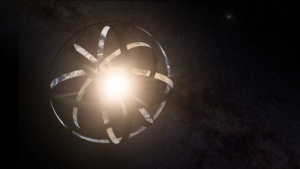Probably never, since a Dyson sphere is not a vacuum cleaner of the same-named famous brand. In fact, until now it is just a thought experiment:
In 1960 Freeman J. Dyson published his theory about the “the long-scale conversion of starlight into far infrared radiation” in Science.[1] He states that aliens with further developed technology than ours must have found an advanced way like this to harvest solar energy.
Such a device could be a shell around the system’s sun at a distance of about two earth orbits, a thickness of 2?3 m, and nearly the mass of Jupiter. All the energy emitted by the star could thus be absorbed and harnessed on the inner surface. Of course, one must first exploit an entire planet to obtain all the mass needed for this device – a huge technical trouble.
But with his hypothesis Dyson also proposed a way to trace intelligent existence in far-away solar systems that was new up to then. Until the 1960s the search for aliens based on the search for extra-terrestrial radio signals. However, a Dyson sphere would appear as a dark object emitting radiation in the far infrared (about 10 µm).[1] Now, instead for only listening to strange radio noise, scanning the sky for abnormalities in the infrared spectrum became also of importance.
Some years ago mankind seemed to be one step closer to discovering a Dyson sphere (or something similar): the light of the star KIC 8462852 shows an immensely changing intensity as if a huge object is regularly passing by. An orbiting planet would be too small to cause such an eclipse. This evokes suspicions about space-factories or cities and even whole Dyson-like devices. But the shadow could probably also be cast by natural causes like the remains of a burst asteroid or an interstellar cloud.[2]
Until we will be able to construct a Dyson sphere millions of years could pass. We first have to develop advanced methods for space-travel and the technology to destruct a whole planet. Not to speak of the energy we will already have consumed on the way.
But then, of course, we might be able to drive our hoovers (or anything else) with energy from a Dyson sphere ;)
— Tatjana Daenzer
Read more:
[1] Dyson F. J., Science 1960, 131, 1667-1668.
[2] https://www.seti.org/seti-institute/mysterious-star-kic-8462852 (last access 16.02.2018).
